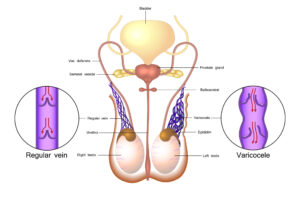Varicocele

A Minimally Invasive Treatment Option for Varicocele
Varicocele is a condition in which the veins within the scrotum become enlarged, causing discomfort, pain, and infertility in some cases. It is similar to varicose veins that occur in the legs, but the veins affected in varicocele are those that drain blood from the testicles.
Varicoceles usually form during puberty and develop over time. They are most commonly found in young men between the ages of 15 and 25 and can often be treated successfully with surgery or non-surgical methods. However, if left untreated, varicoceles can lead to further complications such as testicular atrophy and low testosterone levels.
 A varicocele usually occurs on the left side of the scrotum and often produces no real signs or symptoms. If symptoms are present, they may include:
A varicocele usually occurs on the left side of the scrotum and often produces no real signs or symptoms. If symptoms are present, they may include:
- Dull, aching pain or discomfort when standing; relief when laying down.
- A mass in the scrotum. If large enough, it may resemble a “bag of worms.” Smaller varicocele may only be noticeable by touch.
- Differently sized testicles
- Infertility
Treatment options for varicocele may include pain killers (such as acetaminophen or ibuprofen), embolization or surgery.
Treatment
Varicocele Embolization is a non-surgical, minimally invasive procedure used to divert blood flow away from a varicocele, relieving pain and swelling, and improving sperm quality.
The Procedure
While sedated, a thin catheter is inserted into the affected vein through the femoral or radial artery guided by fluoroscopy. A tiny coil or other material is used to block blood flow and reduce the size of the varicocele.
The Recovery
After the procedure, patients are usually monitored for a few hours in a recovery area before being discharged. They may experience some discomfort or pain in the treated area, and a small amount of bleeding or bruising may occur. Pain medication and ice packs can help manage these symptoms.
Most patients are able to return to their normal activities within two to three days after the procedure, although strenuous exercise and heavy lifting should be avoided for several weeks. Follow-up appointments with the doctor may be necessary to monitor the effectiveness of the treatment and ensure that there are no complications.
Insurance Coverage
Nearly all insurance companies, including Medicaid and Medicare, will cover Varicocele Embolization.
Our team will work with insurance companies to verify coverage for your consultation as well as any procedures you may require.
The Next Step
Patients who are interested in Varicocele Embolization should contact their healthcare provider who will work with our TRA Endovascular team on a plan to evaluate and treat your condition.
Have Questions?
Contact UsAdditional Resources: Radiologyinfo.org
